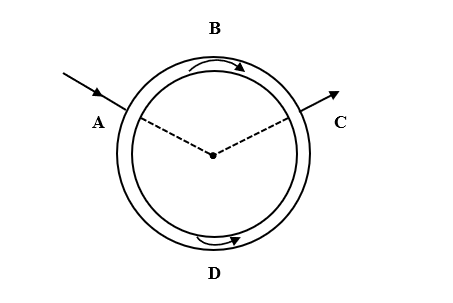
A uniform wire is bent in the form of a circle of radius R. A current I enters at A and leaves at C as shown in the figure:
If the length ABC is half of the length ADC, the magnitude field at the centre O will be


Answer
558.3k+ views
Hint: To solve this problem, use the Ohm's law to find the potential difference in terms of current and resistance. Then we know, relation between resistance and length of the wire substitute in the equation. Then, using the Biot-Savart's law for magnetic fields inside a wire, find the magnetic field in length ABC and then in length ADC. Substitute the relation obtained above in both the equations. Take the ratio of both the equations and find the relation between magnetic field in length ABC and magnetic field in length ADC.
Formula used:
$V=IR$
$R= \rho \dfrac {l}{A}$
$B= \dfrac {{\mu}_{0}Ir}{2\pi{R}^{2}}$
Complete answer:
Direction of current in length ABC is opposite to the direction of current in length ADC. Thus, the direction of magnetic fields due to these currents will also be in opposite directions.
According to Ohm’s Law,
$V=IR$
Where, V is the potential difference
I is the current flowing
R is the resistance
So, applying Ohm’s law across AB we get,
$V= {i}_{1}{R}_{1} = {i}_{2}{R}_{2}$ …(1)
We know, formula for resistivity is given by,
$R= \rho \dfrac {l}{A}$
From above equation we can infer that,
$R \propto l$ …(2)
Substituting equation. (1) in equation. (2) we get,
$V= {i}_{1}{l}_{1} = {i}_{2}{l}_{2}$ …(3)
Now, formula for magnetic field inside a wire given by Biot-Savart’s law is,
$B= \dfrac {{\mu}_{0}Ir}{2\pi{R}^{2}}$
Magnetic field due to length ABC is given by,
${B}_{1}= \dfrac {{\mu}_{0}}{2\pi}\dfrac {{i}_{1}{l}_{1}}{{R}^{2}}$ …(4)
Similarly, Magnetic field due to length ADC is given by,
${B}_{2}= \dfrac {{\mu}_{0}}{2\pi}\dfrac {{i}_{2}{l}_{2}}{{R}^{2}}$ …(5)
Dividing equation. (4) by (3) we get,
$\dfrac {{B}_{1}}{{B}_{2}}= \dfrac {{i}_{1}{l}_{1}}{{i}_{2}{l}_{2}}$
Using equation. (3),
$\dfrac {{B}_{1}}{{B}_{2}}=1$
$\therefore {B}_{1}={B}_{2}$
Hence, both the magnetic fields are equal but are opposite in direction.
Thus, the resultant magnetic field at the center O will be zero.
Note:
Students must remember the basic formulas like Biot-Savart's law and Ohm's law to answer these types of questions. Inside the conductor the magnetic field B increases linearly with radius r. Whereas outside the conductor the magnetic field becomes that of a straight conductor and decreases with increase in radius.
Formula used:
$V=IR$
$R= \rho \dfrac {l}{A}$
$B= \dfrac {{\mu}_{0}Ir}{2\pi{R}^{2}}$
Complete answer:
Direction of current in length ABC is opposite to the direction of current in length ADC. Thus, the direction of magnetic fields due to these currents will also be in opposite directions.
According to Ohm’s Law,
$V=IR$
Where, V is the potential difference
I is the current flowing
R is the resistance
So, applying Ohm’s law across AB we get,
$V= {i}_{1}{R}_{1} = {i}_{2}{R}_{2}$ …(1)
We know, formula for resistivity is given by,
$R= \rho \dfrac {l}{A}$
From above equation we can infer that,
$R \propto l$ …(2)
Substituting equation. (1) in equation. (2) we get,
$V= {i}_{1}{l}_{1} = {i}_{2}{l}_{2}$ …(3)
Now, formula for magnetic field inside a wire given by Biot-Savart’s law is,
$B= \dfrac {{\mu}_{0}Ir}{2\pi{R}^{2}}$
Magnetic field due to length ABC is given by,
${B}_{1}= \dfrac {{\mu}_{0}}{2\pi}\dfrac {{i}_{1}{l}_{1}}{{R}^{2}}$ …(4)
Similarly, Magnetic field due to length ADC is given by,
${B}_{2}= \dfrac {{\mu}_{0}}{2\pi}\dfrac {{i}_{2}{l}_{2}}{{R}^{2}}$ …(5)
Dividing equation. (4) by (3) we get,
$\dfrac {{B}_{1}}{{B}_{2}}= \dfrac {{i}_{1}{l}_{1}}{{i}_{2}{l}_{2}}$
Using equation. (3),
$\dfrac {{B}_{1}}{{B}_{2}}=1$
$\therefore {B}_{1}={B}_{2}$
Hence, both the magnetic fields are equal but are opposite in direction.
Thus, the resultant magnetic field at the center O will be zero.
Note:
Students must remember the basic formulas like Biot-Savart's law and Ohm's law to answer these types of questions. Inside the conductor the magnetic field B increases linearly with radius r. Whereas outside the conductor the magnetic field becomes that of a straight conductor and decreases with increase in radius.
Recently Updated Pages
Master Class 12 English: Engaging Questions & Answers for Success

Master Class 12 Business Studies: Engaging Questions & Answers for Success

Master Class 12 Economics: Engaging Questions & Answers for Success

Master Class 12 Social Science: Engaging Questions & Answers for Success

Master Class 12 Maths: Engaging Questions & Answers for Success

Master Class 12 Chemistry: Engaging Questions & Answers for Success

Trending doubts
What are the major means of transport Explain each class 12 social science CBSE

Which are the Top 10 Largest Countries of the World?

Draw a labelled sketch of the human eye class 12 physics CBSE

Explain sex determination in humans with line diag class 12 biology CBSE

The pH of the pancreatic juice is A 64 B 86 C 120 D class 12 biology CBSE

Explain sex determination in humans with the help of class 12 biology CBSE




